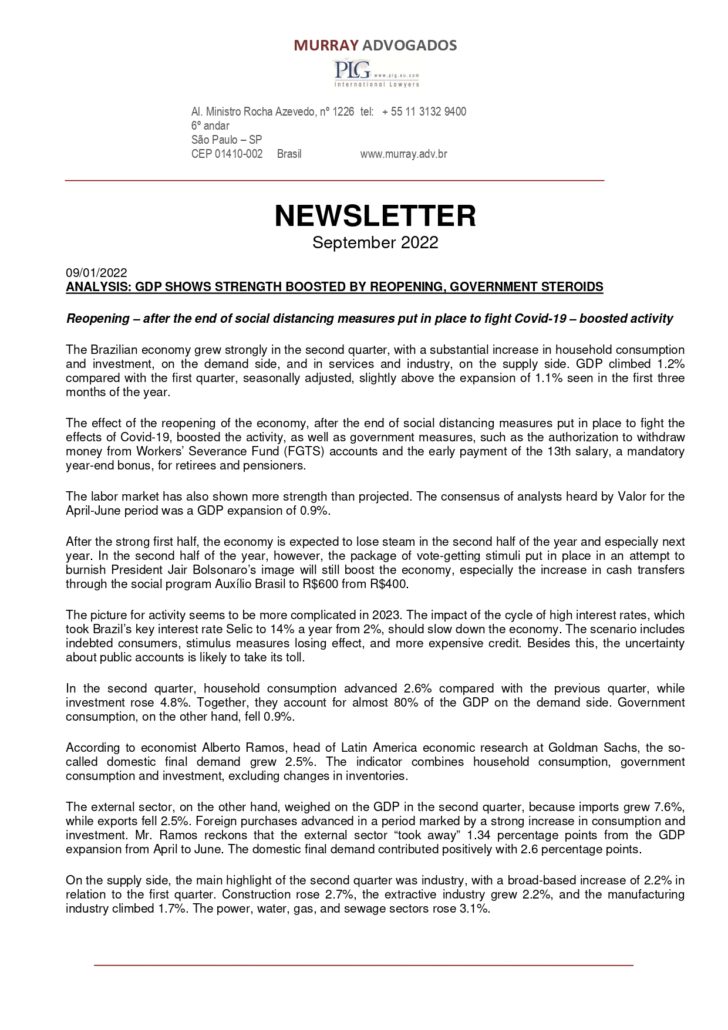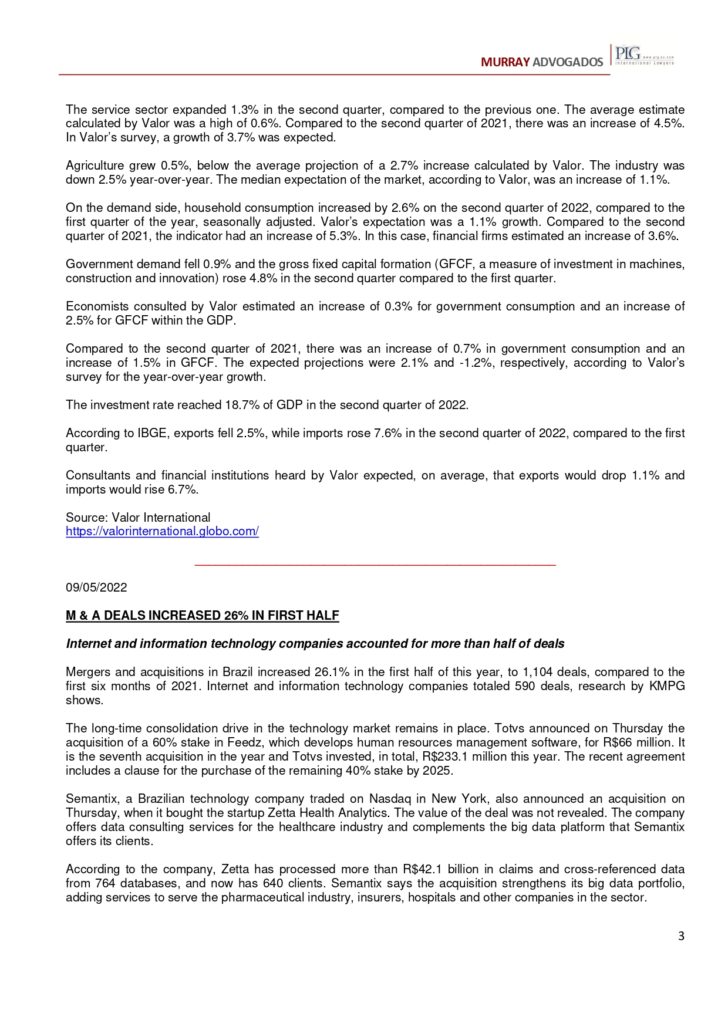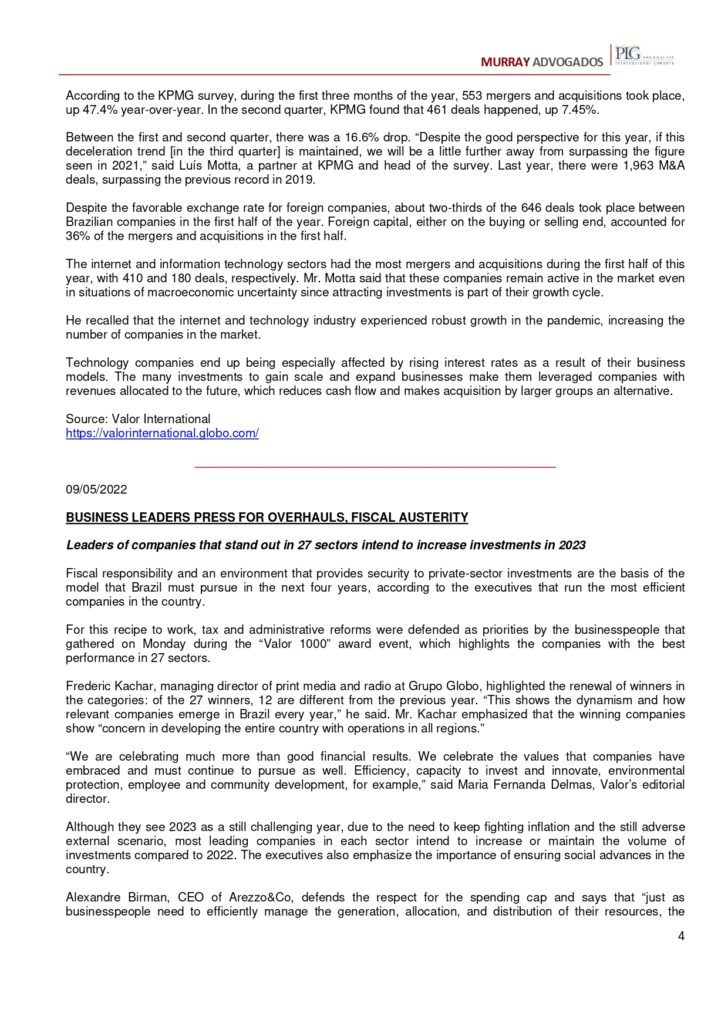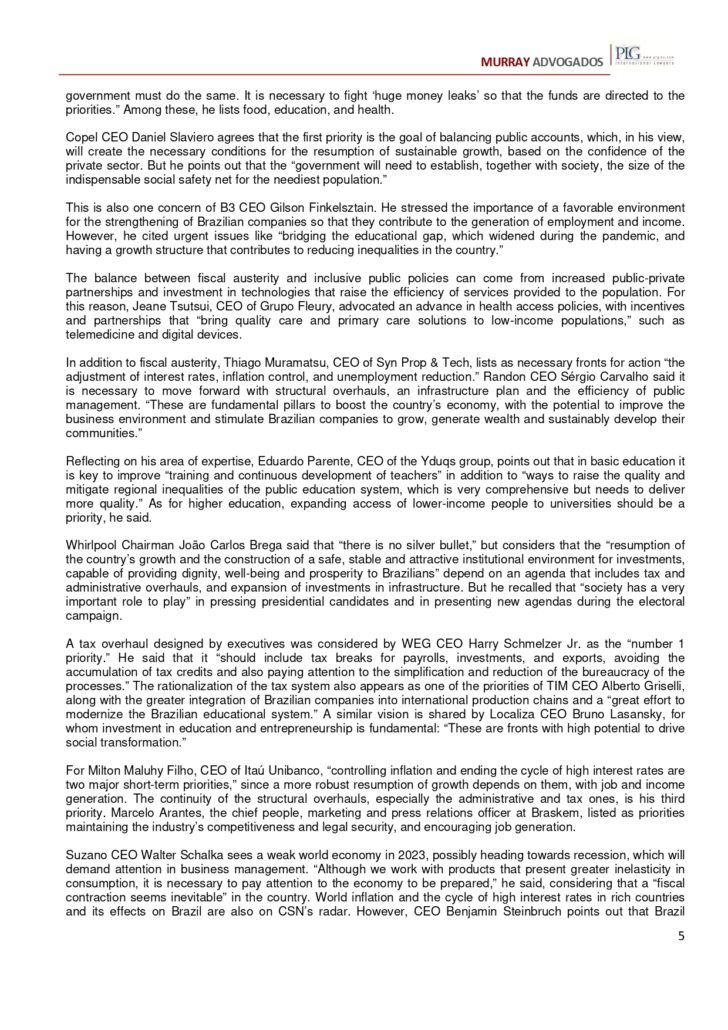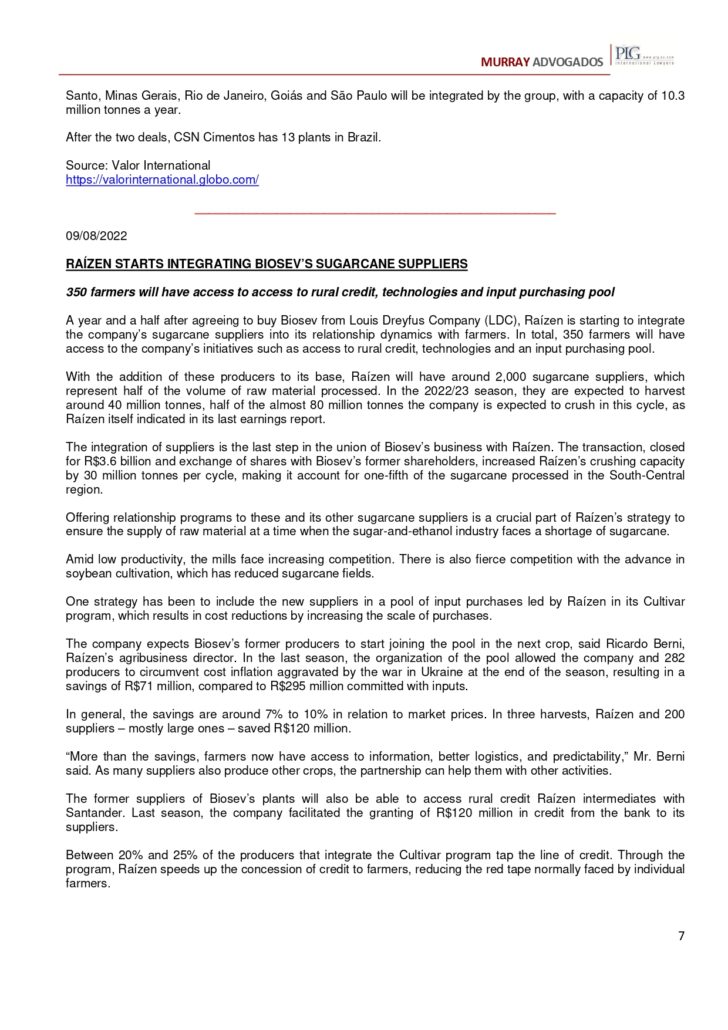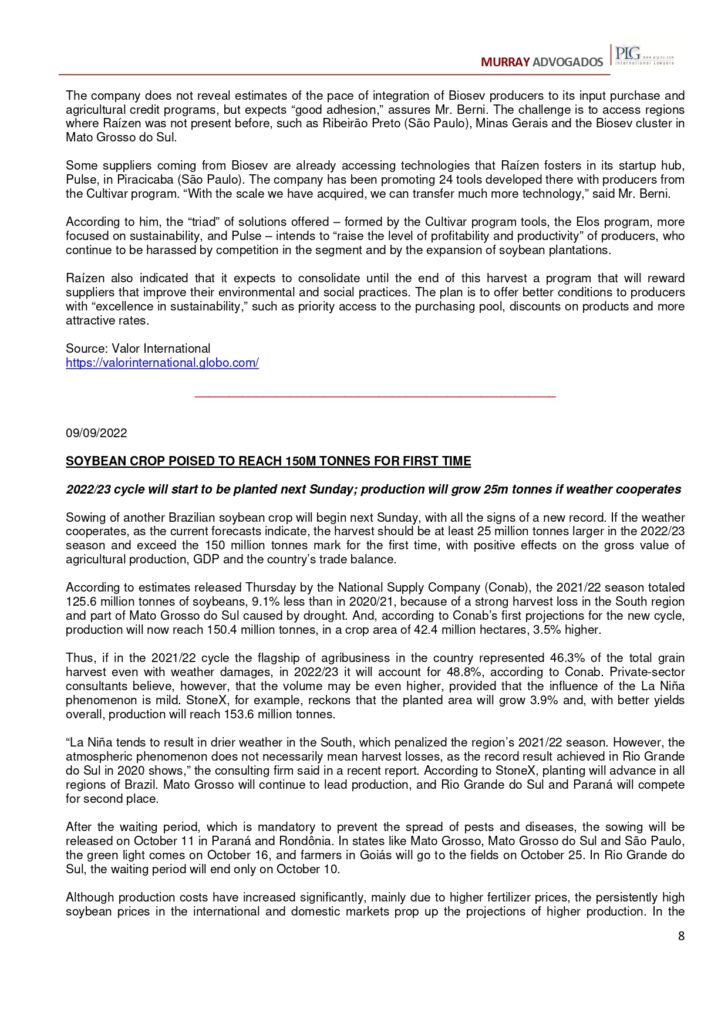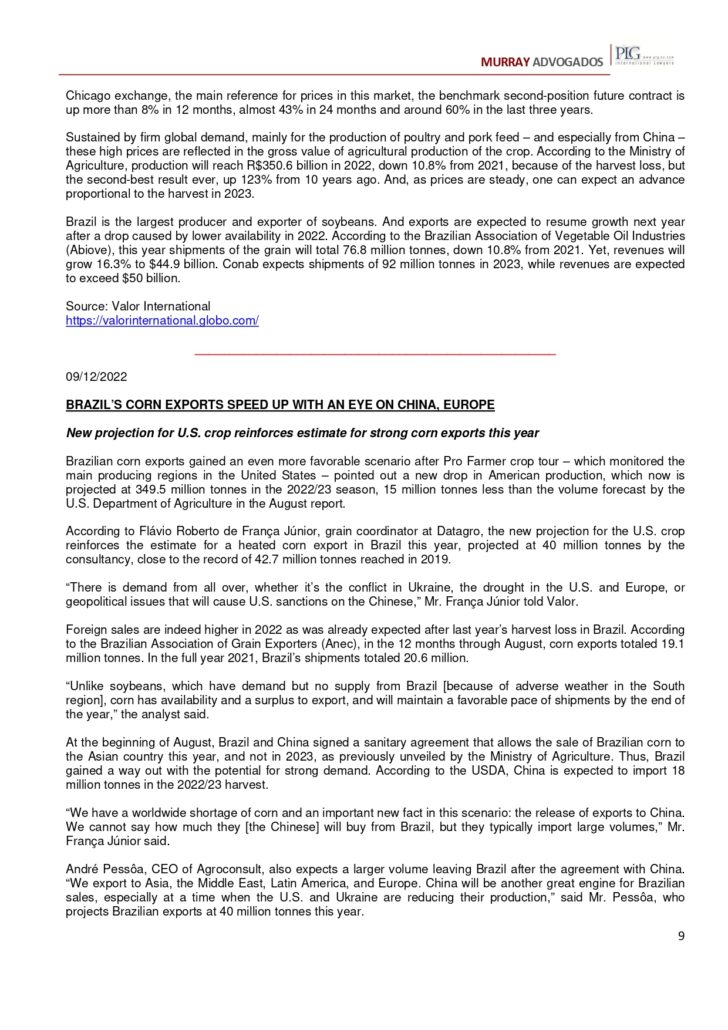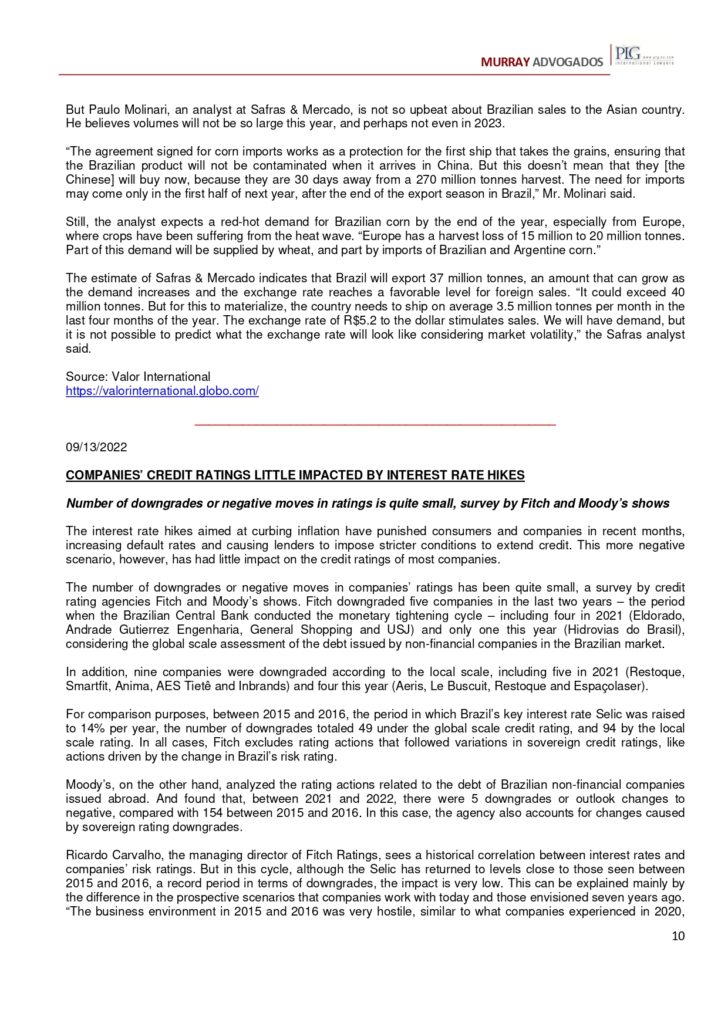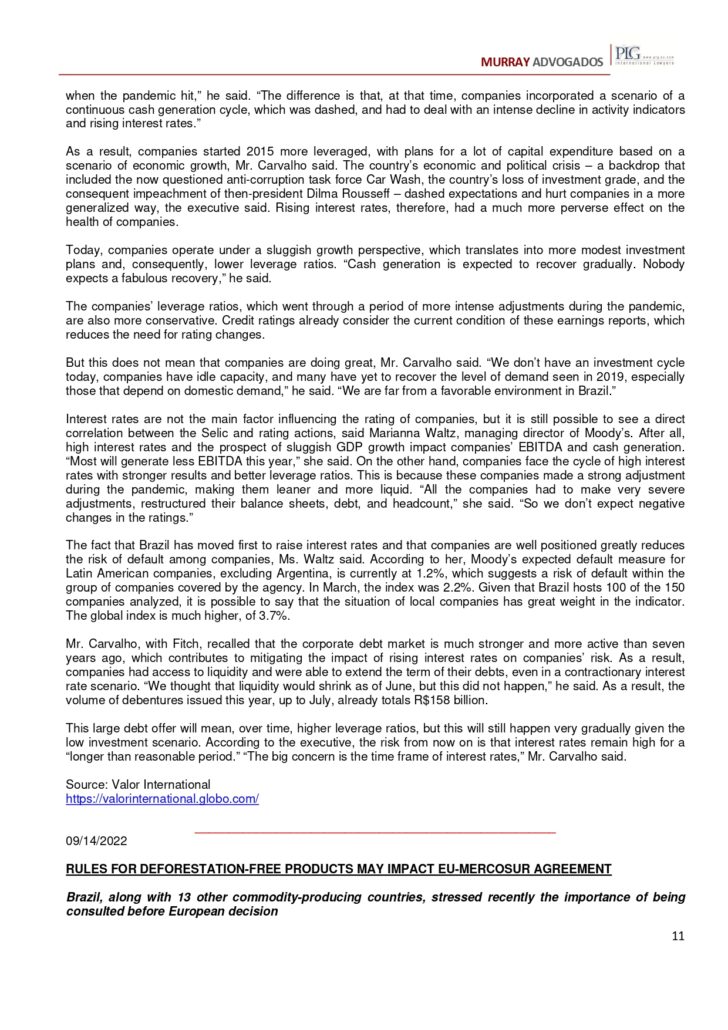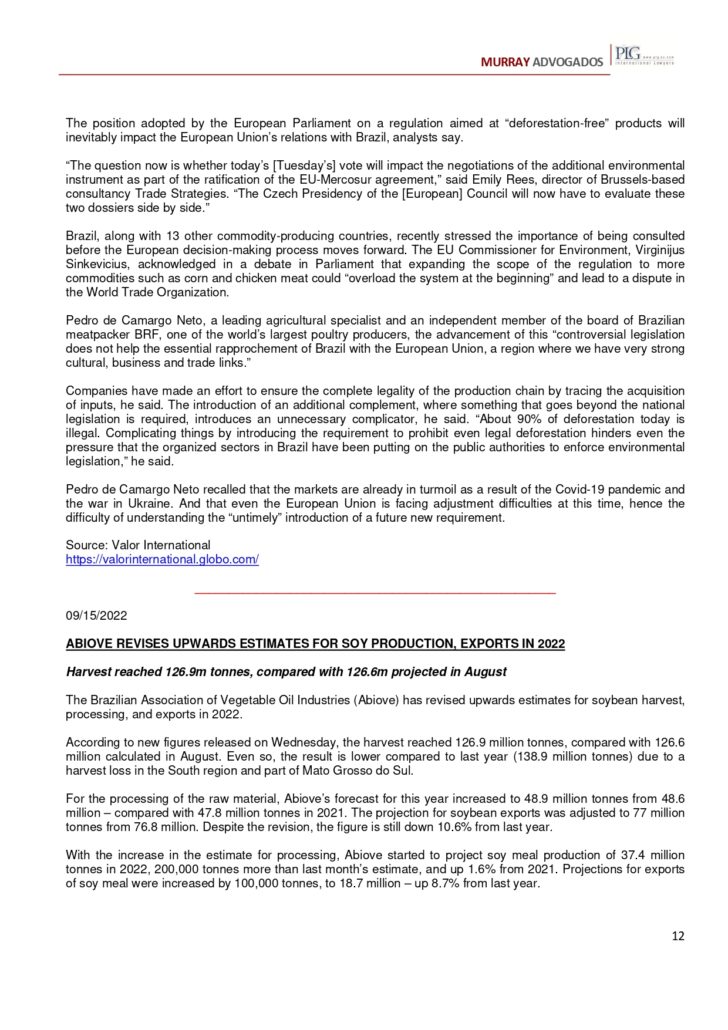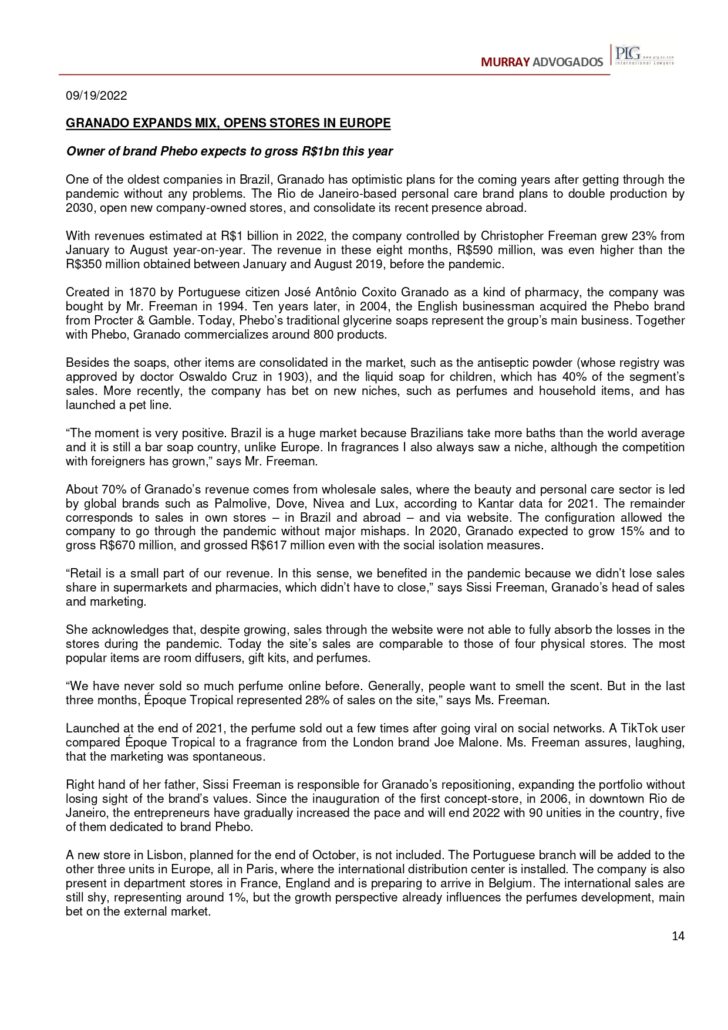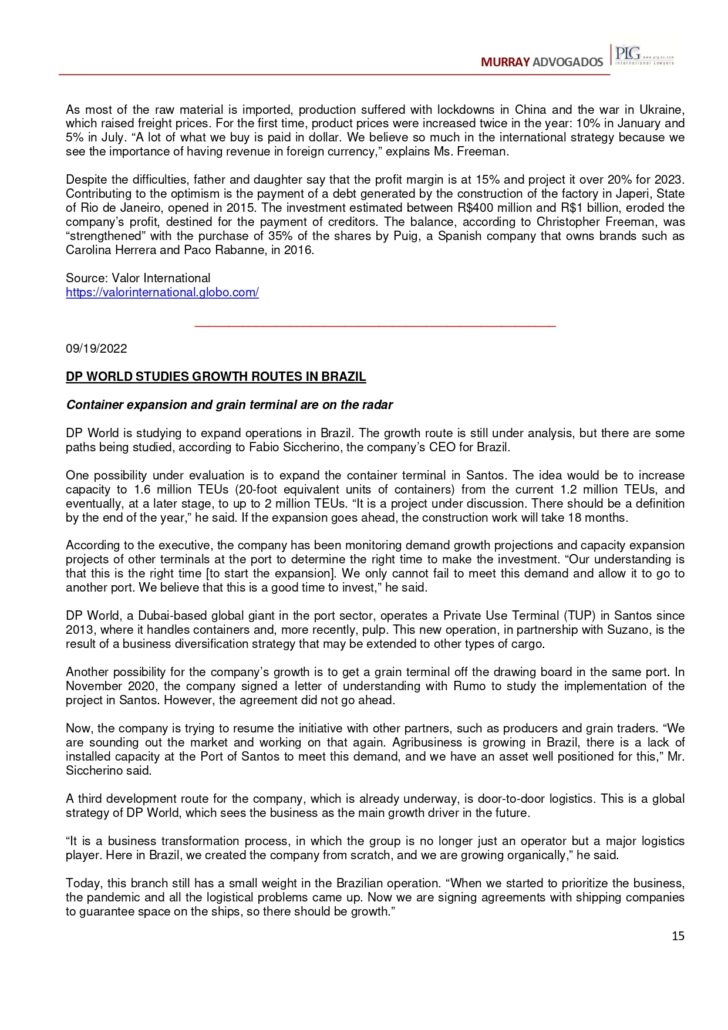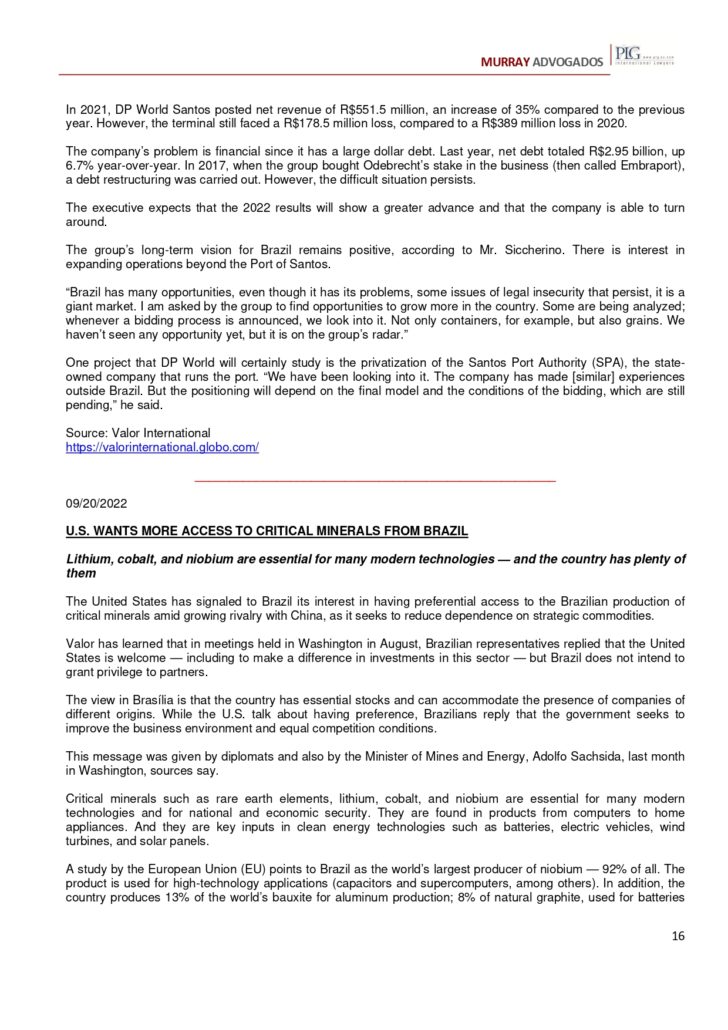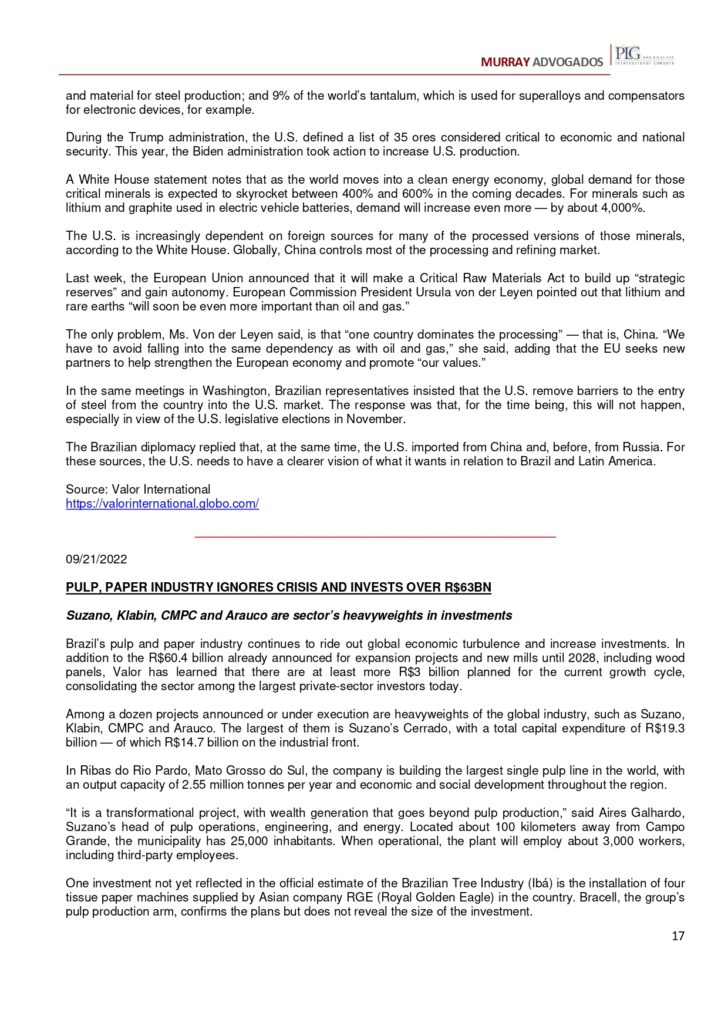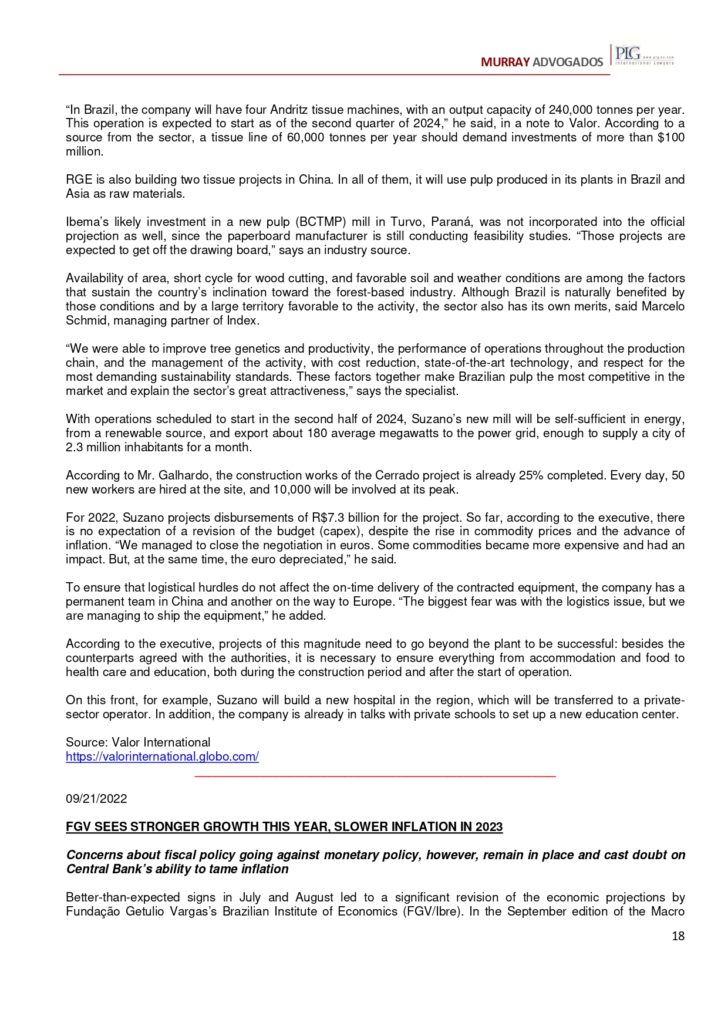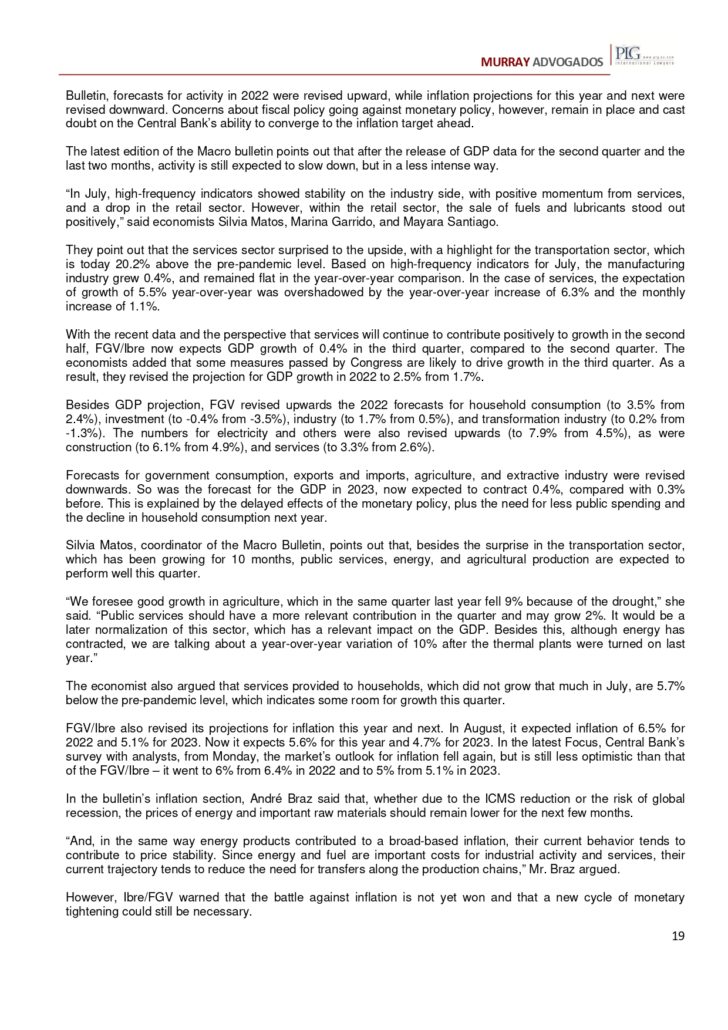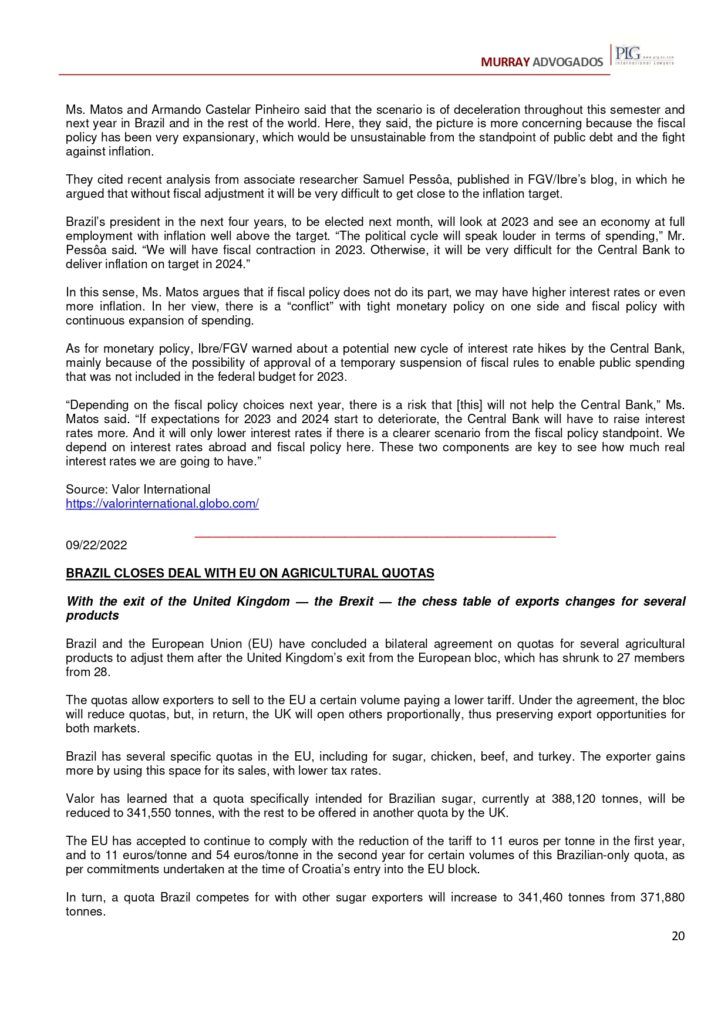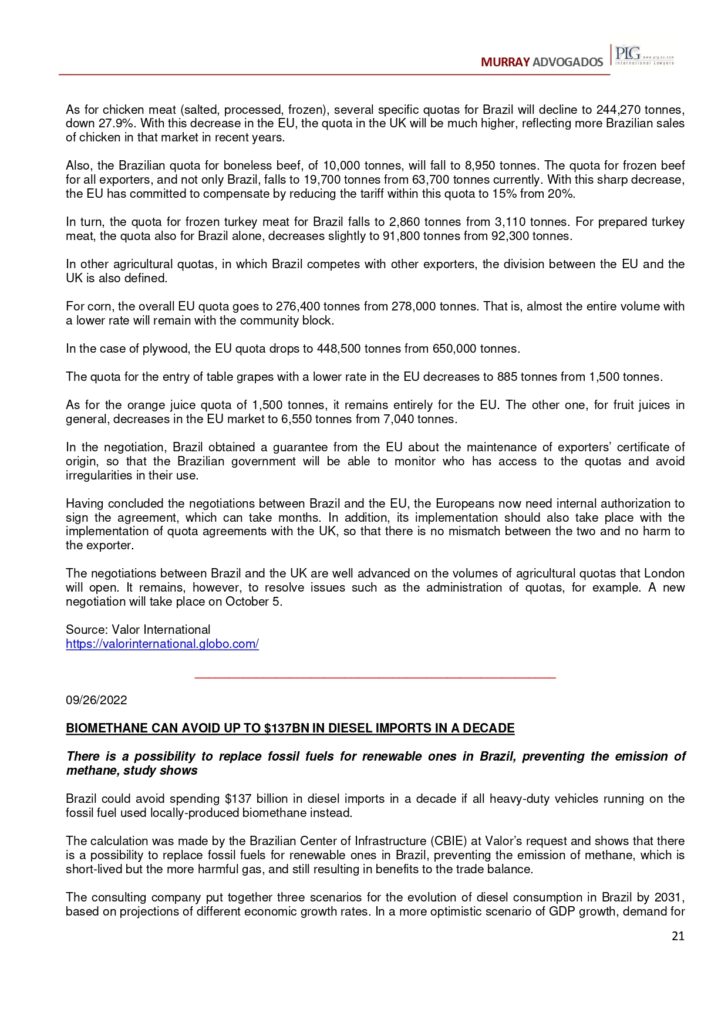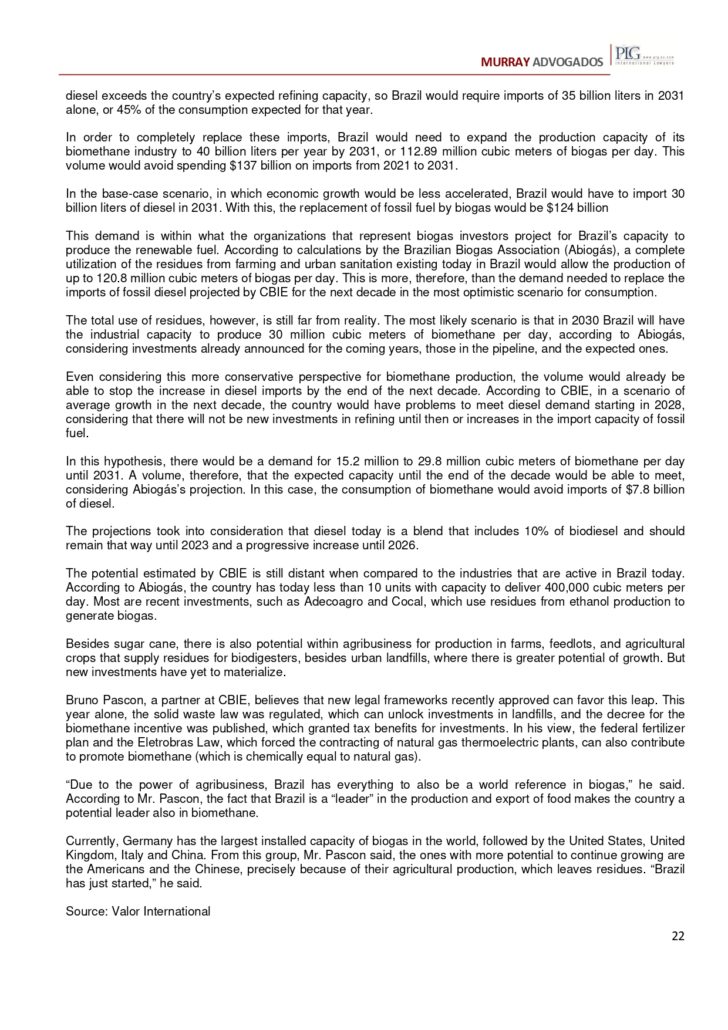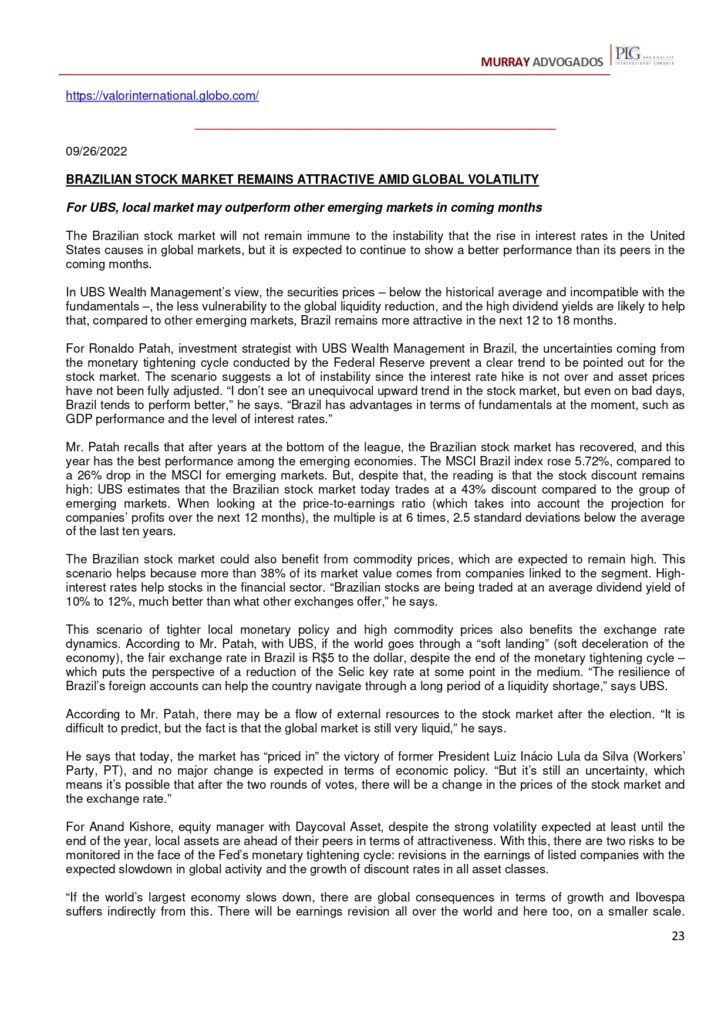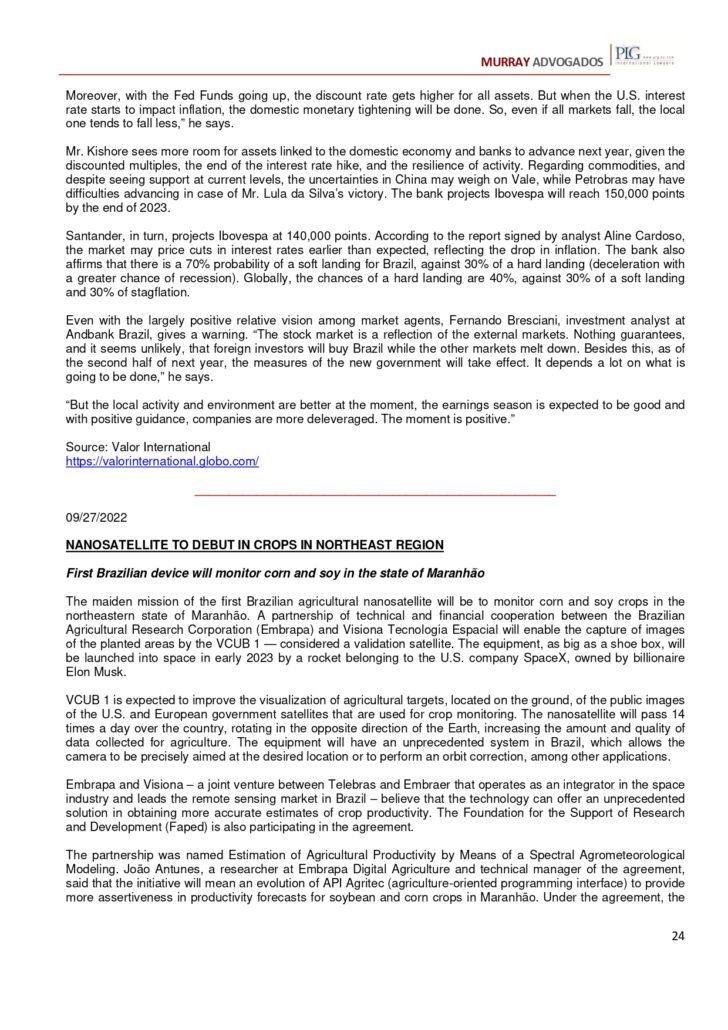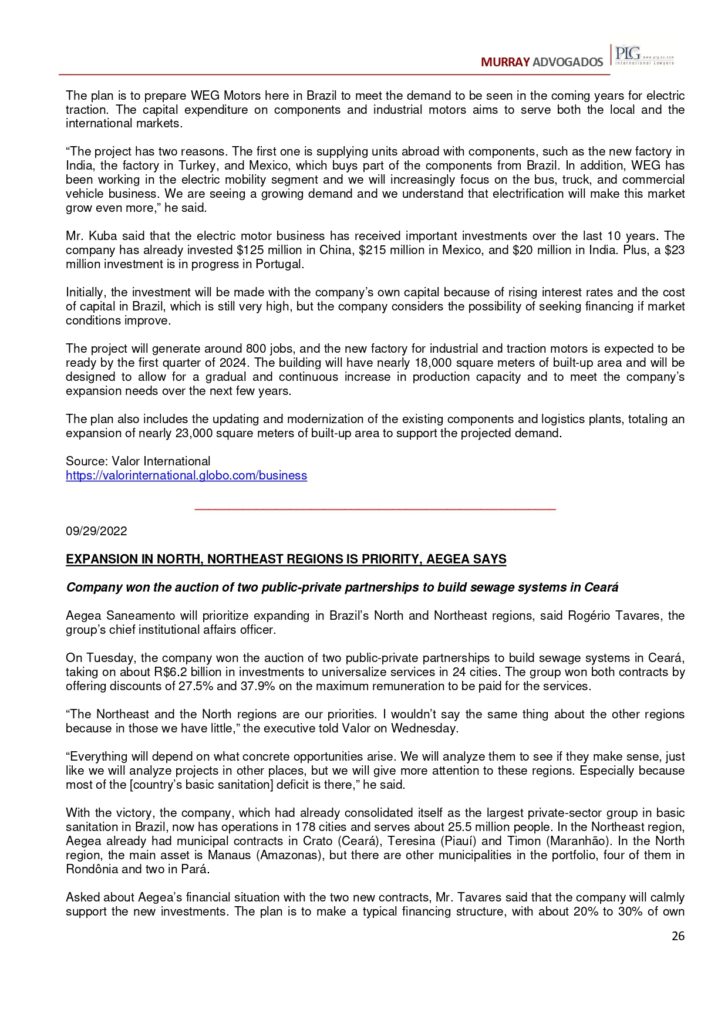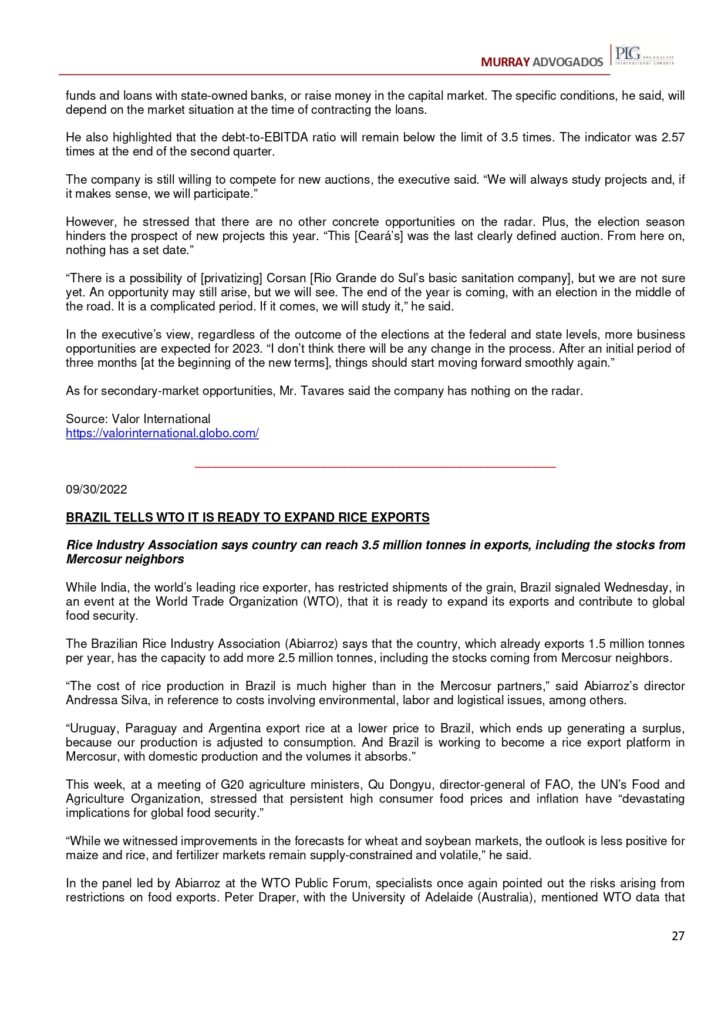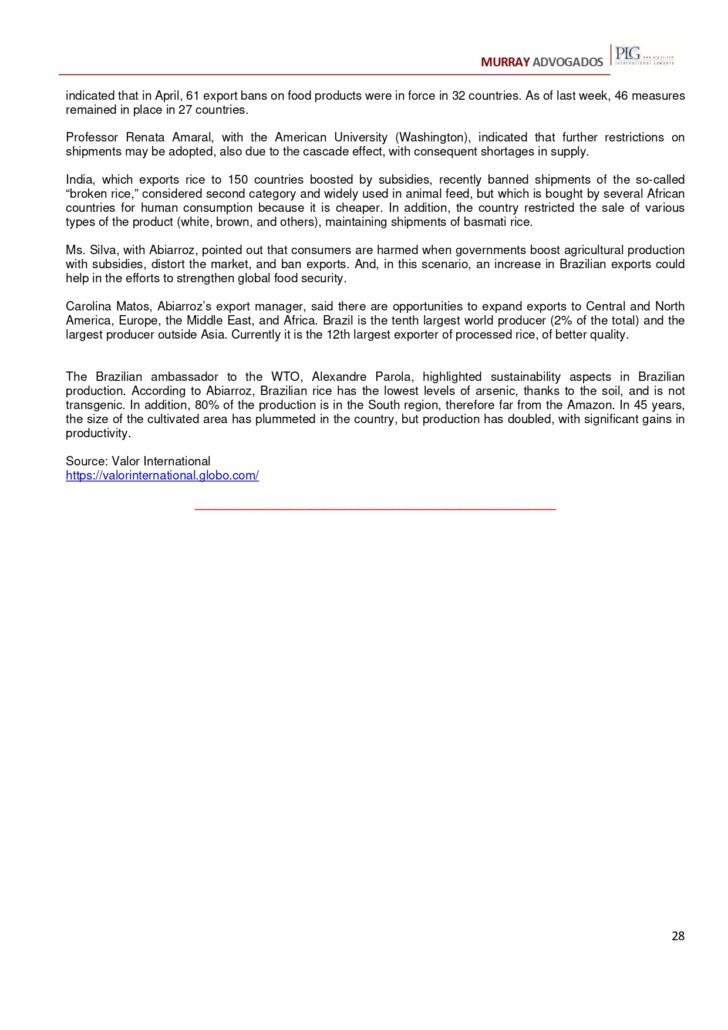Convergence of Brazilian policies with normative instruments will have to be more than promises
09/30/2022
/i.s3.glbimg.com/v1/AUTH_37554604729d4b2f9f3eb9ad8a691345/internal_photos/bs/2021/k/A/FB7T5gQnuaBLAhfNo6Aw/ocde-divulgacao-ocde.jpg)
Brazil submitted its application to join the OECD in May 2017 — Foto: Divulgação/OCDE
The Bolsonaro administration is expected to present this Friday to the Organization for Economic Cooperation and Development (OECD) — on the eve of the first round of the presidential election — the memorandum necessary to effectively begin negotiations to join the body.
Sources in the private sector believe there is resistance from the Workers’ Party (PT) candidate, Luiz Inácio Lula da Silva, to work for Brazil to join the OECD. The annoyance with this position — together with an eventual plan to reopen the Mercosur-European Union agreement and to create an export tax on agricultural products — would have been taken to Mr. Lula da Silva, who publicly has not talked about the subjects any further. However, neither is it clear what his administration would do.
Brazil submitted its application to join the OECD in May 2017. It waited five years to receive the invitation letter in June of this year to start negotiating the conditions for becoming a member.
Now, the government will present the so-called initial memorandum on Friday. This is a report in which Brazil answers about the degree of convergence of Brazilian policies with 230 of 262 normative instruments of the OECD.
Basically, the country has to say whether it has already implemented or how it intends to align with all these OECD practices or recommendations. The entity then distributes the report to 26 committees, which will send out questionnaires, and make visits to the country, among other things.
What is apparently a technical job is, however, becoming increasingly political. Member countries have already made it clear to Brazil that, this time, no candidate country will leave any measure for later, based on future promises. In other words, there is no admittance with a “debt,” unlike what happened to countries like Chile and Colombia, which continued to justify why they did not complete the implementation of certain commitments years after they became partners.
So, Brazil will first need to reduce deforestation in order to be accepted. It is not going to be possible just to present a deforestation reduction target.
Besides this, member countries expect greater common engagement, which pushes the “like-minded” issue into the political arena. In other words, foreign policy will enter strongly into the negotiations for Brazil to join the OECD, unlike what happened with other countries that are already inside the organization today.
An example happened in March when Brazil abstained from a vote to condemn Russia at UNESCO — which has nothing to do with the economy and the OECD. European countries showed intense annoyance. Brazil’s Foreign Affairs Ministry, known as Itamaraty, argued that it had already voted in the UN Security Council against Russia, but that it considered that Unesco was not the forum for that kind of initiative. It took a lot of explanations until the path was reopened for the OECD invitation, in June. But the message was clear to Brasília, whoever the president.
*By Assis Moreira — Geneva
Rice Industry Association says country can reach 3.5 million tonnes in exports, including the stocks from Mercosur neighbors
09/30/2022
While India, the world’s leading rice exporter, has restricted shipments of the grain, Brazil signaled Wednesday, in an event at the World Trade Organization (WTO), that it is ready to expand its exports and contribute to global food security.
The Brazilian Rice Industry Association (Abiarroz) says that the country, which already exports 1.5 million tonnes per year, has the capacity to add more 2.5 million tonnes, including the stocks coming from Mercosur neighbors.
“The cost of rice production in Brazil is much higher than in the Mercosur partners,” said Abiarroz’s director Andressa Silva, in reference to costs involving environmental, labor and logistical issues, among others.
“Uruguay, Paraguay and Argentina export rice at a lower price to Brazil, which ends up generating a surplus, because our production is adjusted to consumption. And Brazil is working to become a rice export platform in Mercosur, with domestic production and the volumes it absorbs.”
This week, at a meeting of G20 agriculture ministers, Qu Dongyu, director-general of FAO, the UN’s Food and Agriculture Organization, stressed that persistent high consumer food prices and inflation have “devastating implications for global food security.”
“While we witnessed improvements in the forecasts for wheat and soybean markets, the outlook is less positive for maize and rice, and fertilizer markets remain supply-constrained and volatile,” he said.
In the panel led by Abiarroz at the WTO Public Forum, specialists once again pointed out the risks arising from restrictions on food exports. Peter Draper, with the University of Adelaide (Australia), mentioned WTO data that indicated that in April, 61 export bans on food products were in force in 32 countries. As of last week, 46 measures remained in place in 27 countries.
Professor Renata Amaral, with the American University (Washington), indicated that further restrictions on shipments may be adopted, also due to the cascade effect, with consequent shortages in supply.
India, which exports rice to 150 countries boosted by subsidies, recently banned shipments of the so-called “broken rice,” considered second category and widely used in animal feed, but which is bought by several African countries for human consumption because it is cheaper. In addition, the country restricted the sale of various types of the product (white, brown, and others), maintaining shipments of basmati rice.
Ms. Silva, with Abiarroz, pointed out that consumers are harmed when governments boost agricultural production with subsidies, distort the market, and ban exports. And, in this scenario, an increase in Brazilian exports could help in the efforts to strengthen global food security.
Carolina Matos, Abiarroz’s export manager, said there are opportunities to expand exports to Central and North America, Europe, the Middle East, and Africa. Brazil is the tenth largest world producer (2% of the total) and the largest producer outside Asia. Currently it is the 12th largest exporter of processed rice, of better quality.
/i.s3.glbimg.com/v1/AUTH_37554604729d4b2f9f3eb9ad8a691345/internal_photos/bs/2021/T/e/UJ0WpdQaS7E24Y3ElSzw/01bra-100-omc-a3-img01.jpg)
Alexandre Parola — Foto: Ailton de Freitas/Agência O Globo
The Brazilian ambassador to the WTO, Alexandre Parola, highlighted sustainability aspects in Brazilian production. According to Abiarroz, Brazilian rice has the lowest levels of arsenic, thanks to the soil, and is not transgenic. In addition, 80% of the production is in the South region, therefore far from the Amazon. In 45 years, the size of the cultivated area has plummeted in the country, but production has doubled, with significant gains in productivity.
*By Assis Moreira — Geneva
Source: Valor International
Itaú survey shows that the decoupling of activity may bring down the occupation rate at the end of the year
09/30/2022
/i.s3.glbimg.com/v1/AUTH_37554604729d4b2f9f3eb9ad8a691345/internal_photos/bs/2022/K/V/WOi5igQLGQLahIyIUvvQ/dsc2175.jpg)
Natalia Cotarelli — Foto: Divulgação
Both the labor market and economic activity in Brazil have surprised to the upside this year, but the recovery in employment has been sharper than it would be consistent with the evolution of the country’s GDP growth itself, economists say. Beyond some structural change that would make some of this gain permanent, the finding suggests that this very positive trend for employment may be short-lived.
In economic theory, there is an inverse relationship between GDP and the unemployment rate (the so-called Okun’s Law). A study by Itaú Unibanco shows that until the third quarter of 2021, the variation in unemployment was consistent with the performance of the economic activity, but since the fourth quarter of 2021, the data seems to have become decoupled. “The unemployment rate ended up falling much more than the GDP growth would suggest, according to the rule,” said Natalia Cotarelli, an economist at Itaú and a co-author of the study, along with Matheus Fuck and Claudia Bruschi.
The seasonally adjusted unemployment rate fell to 8.8% in the three months to July from 11.5% in the January quarter, despite the strong recovery in the labor market participation rate, which rose to 63.5% from 61.7% in the period, notes Itaú. In other words, the growth of the employed population more than offset the return of part of the people looking for work.
For Itaú, a labor market stronger than activity would suggest reflects a sectoral composition effect of growth — with the reopening of the more labor-intensive service sector in the post-pandemic — and some impact of the 2017 labor reform.
In the first and second quarters of this year, GDP expanded 1.1% and 1.2%, in that order, on a seasonally adjusted quarter-over-quarter comparison, with the services sector accounting for more than half of the growth (0.7 and 0.8 percentage points, respectively), Itaú notes. “The recovery of the employed population in these very labor-intensive sectors was stronger in late 2021 and early 2022,” said Ms. Cotarelli.
In this scenario, the average productivity of the economy (which jumped during the pandemic because of the resilience of capital-intensive sectors, which are more productive) started to decelerate and seems to have returned to the pre-pandemic pattern, the bank said. This, according to Itaú, indicates that the labor market is likely to return to growth more in line with the evolution of GDP ahead.
“The outlook now is for a labor market moving basically sideways in the second half of the year,” said Ms. Cotarelli. Itaú expects the unemployment rate to rise to 9.1% in December from 8.8% in the July quarter, and to rise to 10.1% by the end of 2023.
The impact of the labor overhaul on the economy is more uncertain, Itaú acknowledged, but some data and academic studies have pointed out that the changes may have generated positive effects on the market, for example by reducing the filing of labor lawsuits and, therefore, costs. All other things being equal, this fall may increase the demand for labor without raising the cost of labor, which tends to reduce the non-accelerating inflation rate of unemployment (NAIRU) — the rate beyond which there is pressure on inflation.
After the labor overhaul passed in Congress in 2017, the proportion of formal employment in relation to the total seems to have stopped the downward trend that had taken place since 2015, notes Itaú. “In 2018, it became stagnant, which could indicate some effect of the overhaul. The pandemic came and everything became very distorted, but now it seems that this proportion has stabilized at the level close to 2018, suggesting an impact of the reform for formal jobs,” said Ms. Cotarelli.
Bráulio Borges, a senior economist at LCA Consultores and an associate researcher at the Brazilian Institute of Economics (FGV/Ibre), said that the real “outlier” in the relationship between GDP and unemployment rate in Brazil was the second quarter of 2022.
Mr. Borges reweighted the participation of the GDP sectors not by their value added to the total economy, as statistics agency IBGE does, but by the number of people employed in those segments. In the first half of 2022, this “GDP from the point of view of occupation” rose 5%, compared to the equivalent moment in 2021, almost twice the official GDP advance in the period, of 2.7%. Since 1995, never in a two-year period has the GDP been so “pro-employment” as in 2021-2022, notes Mr. Borges.
This difference between the GDP reweighted by occupation and the official one happens, according to the economist, because the sectors that are growing the most this year are labor-intensive, such as services and construction, but, in general, of low productivity – that is, they generate many jobs, but add relatively less value to the economy. “I have more employment than GDP,” said Mr. Borges.
By submitting this reweighted GDP to Okun’s Law — which Mr. Borges further divides by the working-age population (14 or older), to add a notion of labor “supply” — the economist managed to maintain the relationship between GDP and unemployment rate even in the fourth quarter of 2021 and the first quarter of 2022. “But it is not possible to understand the behavior of the labor market in the second quarter merely by sectorial composition,” said Mr. Borges.
In the period, 4.4 million new jobs were created, or 18 million in annualized terms, which would be compatible with a GDP varying around 5%, according to the economist. In the first half of the year, however, GDP grew 2.5% year over year, and the median of the Central Bank’s Focus survey with analysts indicates a growth of 2.7% for the year.
According to Mr. Borges, a more structural change could be taking place in the relationship between activity and the unemployment rate because of the greater flexibility introduced in the market after the 2017 labor overhaul. For him, however, the signs in this direction are not yet so robust, so Mr. Borges bets more on an early effect of hiring.
Mr. Borges recalled that at the end of the second quarter, the government signaled that it would make other stimuli near the elections. “This may have prompted hiring in sectors of the economy due to the expectation that activity would still be strong in the third quarter,” he says.
This is a hypothesis that will be “easily verifiable” or not as the data are published, says Mr. Borges. For every percentage point that the GDP grows above the working-age population (PIA), unemployment in Brazil drops 0.5 points. For demographic reasons, the PIA has been growing 0.8% per year, while the Focus indicates 0.5% growth for the GDP in 2023. “There is an indication that unemployment may rise next year,” said Mr. Borges.
In Mr. Borges’s projections, GDP from the perspective of occupation should still advance 4.5% in 2022, for an overall GDP growth of 2.8% estimated by LCA. In 2023, however, this difference would be eliminated, with both rising 0.4%.
*By Anaïs Fernandes — São Paulo
Source: Valor International
Cheaper iron ore and oil will start to reflect in second half results
29/09/2022
Brazilian companies dealing in commodities had been in an exceptional operating moment since the second half of 2020, with the recovery after the first wave of the pandemic. The rapid recovery of the world economy has caused iron ore, oil and pulp prices to soar, boosting revenues. In this second half of 2022, however, the basis of comparison with previous periods, associated with fears of economic recession that put pressure on prices, are expected to begin to reflect on results.
Iron ore prices tumbled 36.4% in comparison to the average in the third quarter of 2021, according to the S&P Platts index, and 24.5% over the average in the second quarter of this year, considering the average of $103.83 a tonne in the current quarter through Thursday. Less appetite from China, the commodity’s main buyer, has also pressured steel prices in Brazil and in foreign markets.
If since 2020, the restrictive circulation measures in the rest of the world as opposed to the moment closer to “normal” in China have led to shortages, now the circulation restrictions in the Asian country and the deceleration of the local economy affect prices. “What lifted prices in the post-pandemic period was the restriction in supply, with mining and steel companies still struggling to meet pent-up demand,” says Daniel Sasson, analyst with Itaú BBA. “Today we have a fairly challenging scenario in terms of economic activity in China, with initiatives to boost it not doing very well.”
/i.s3.glbimg.com/v1/AUTH_37554604729d4b2f9f3eb9ad8a691345/internal_photos/bs/2022/w/5/4zcwtnShSVTR2iAsMv3Q/30emp-100-comm-b4-img02.jpg)
Gabriela Joubert — Foto: Divulgação
“The expectations for mining companies is that revenues will be lower because prices are lower, even with a recovery in sales volume, both in annual and quarterly,” says Gabriela Joubert, chief equity analyst with Inter. In steel, she believes that the domestic market will not feel the drop in international prices as much because of recent readjustments in the companies.
Mr. Sasson sees different impacts for each company. “The concerns we see today is with this synchronized global deceleration, although short-term pressures are evident, the bigger question is to understand where profitability and margin levels will stabilize,” he says. The executive points out that companies like Gerdau, less exposed to ore, will sustain better results than Vale, CSN or Usiminas in the quarter.
Oil prices also felt the drop in the current quarter. The Brent barrel, used as a reference by the Brazilian companies, has an average price of $95.67 in the quarter, which represents a 12.8% drop compared to the second quarter. In the annual comparison, however, there was an increase of 31.8%.
“In these last quarters we have seen growing doubts about the global demand for oil, with expectations of lower-than-expected growth in the economy, amid accelerated inflation and high interest rates to contain these effects,” explains Ilan Abertman, analyst at Ativa Investimentos. He points out that the uncertainties about supply end up sustaining the price near $100 a barrel.
Ms. Joubert recalls that the member countries of the Organization of Petroleum Exporting Countries (OPEC) are having difficulty in raising production levels, which creates more triggers than in the ore case to maintain prices. “We will see a quarterly drop in revenues, but still above historical levels. What is likely to happen is a balancing of expectations,” she says.
Mr. Abertman does not see very big changes in the companies’ fundamentals even with the quarterly drop in oil prices. “On the revenue side we won’t have oil at $110 per barrel anymore. At $90, however, is still higher than a year ago, and in the case of Petrobras, there is a pre-salt premium that ends up offsetting the price,” he says.
In terms of costs for the companies, the drop in oil and ore prices should not necessarily translate into relief in this line on their earnings reports. Analysts remember that there is an equity equivalence accounting effect that in which items are only posted in the financial statements when they are used, and not when they are purchased.
“A steelmaker still uses more expensive coal or ore bought at the beginning of the year, for example, which limits cost relief effects, at least in the quarterly comparison,” says Mr. Sasson. According to him, in the fourth quarter the cheaper basic materials are expected appear more strongly in the results.
The scenario for pulp is different. A survey by BTG Pactual shows that hardwood pulp (BHKP) traded in China closed at $863.95 a tonne last Friday, which represents a rise of 2.57% over July 1th and 44% over October 1th, 2021. Prices still at the top are expected to boost the revenues of the companies in the sector, analysts say.
“Demand remains very strong, and we had a bigger supply shock than in other commodities because of the suspension of certification of Russia’s wood with the sanctions,” says Ms. Joubert, with Inter. She points out that the shortage of wood used to manufacture pulp, together with the still high demand for paper and packaging in Brazil and abroad, help keep prices high.
Mr. Abertman, with Ativa, says the market is already pricing in a contraction in pulp in Suzano and Klabin securities, wondering if the current price above $800 a tonne is sustainable. “But from an operational point of view, the two companies had no operational downtime in the third quarter, which will end up generating higher revenues in the year-on-year and quarter-on-quarter comparisons.”
“We may even see signs of a more significant drop in the fourth quarter, but it is difficult to see it in the companies’ results,” says Mr. Sasson, with Itaú BBA. He points out that the dynamics of the pulp market, with more spaced contracts than those of ore and oil, increases the temporal space in which price variations are actually captured by the companies in their earning reports.
*By Felipe Laurence — São Paulo
Source: Valor International
Brazil’s second-largest food retailer is seeking to recover share in the premium segment
09/29/2022
/i.s3.glbimg.com/v1/AUTH_37554604729d4b2f9f3eb9ad8a691345/internal_photos/bs/2022/A/a/G5PwPOT2OClvU1oXYqvw/220922-20pao-20de-20acucar-20006.jpg)
Marcelo Pimentel — Foto: Carol Carquejeiro/Valor
In his first interview since taking over Brazil’s second-largest food retailer GPA (Grupo Pão de Açúcar), six months ago, CEO Marcelo Pimentel has a clear perception that there is a short window open for the group to start changing its numbers and start presenting better results to the market.
Mr. Pimentel says that the attention of investors right now is on the opportunity to monetize the Colombian group Éxito, a business that is part of GPA today but is likely to be spun off. This buys GPA time to put the house in order.
GPA seeks to regain the market lost in the premium segment in recent years, in addition to trying to accelerate the occupation of spaces in minimarkets, a terrain of strong competition. “Today, the focus of expansion is 90% in Pão and Minuto Pão de Açúcar,” he said. Of the 300 stores to be opened by 2024, 250 will be of brands such as Minuto and Mini Extra.
Between April and June, GPA posted R$4.4 billion in gross sales, up 4.6%. Margins fell and the R$65 million profit a year earlier turned into a R$135 million loss in the second quarter.
Besides the announced plan to spin off Éxito, there is still information in the market about the possibility of the controlling shareholder Casino getting rid of assets in the world, including Brazil. GPA has already manifested itself about it week ago, denying knowing anything like that. “The agreement I have with the board and with my peers is of total transparency about everything we have done. We have been careful to talk to the team beforehand and explain the reason for each movement, including showing the future path”, he says.
Read below the main excerpts from the interview.
Valor: What is the biggest challenge of the group today?
Marcelo Pimentel: I started talking to the group in December 2021 and the main issue was to understand the decision of leaving hypermarkets, an extremely brave decision and a turning point for us. Extra was a model that generated cash flow, but not results, and the decision was to focus again on our DNA. My mission at the new GPA is to focus on proximity stores, supermarkets, and multichannel, digital sales. I say it is like a plane with two wings, with the Pão de Açúcar and Minuto Pão de Açúcar chains on one wing. And the Minuto is no longer something disconnected, but something complementary to Pão, and the message of both must be the same. It has to have the same convenience DNA, the quality of the products.
Valor: And what about the other chains in the group?
Mr. Pimentel: On the other side of the wing of this plane are our mainstream brands: Mercado Extra, Compre Bem, and Mini Extra. But in the short term, looking at two to three years, our focus is absolutely on rescuing Pão de Açúcar [supermarkets]. This is where we need to get back to being a reference in the premium market for the upper classes, and Minuto talks about this with Pão de Açúcar. We are not actively focused on Mercado Extra and Mini Extra. And how are we going to do this? We have reviewed, in the last five months, since I joined the company, everything that was happening. All the strategic vision and, in practice, all the projects.
Valor: Can you give examples?
Mr. Pimentel: I came in and asked to make an inventory of all the projects that were happening in the different areas, and the fact is that we were with a lot of things in this process of trying to win, and in the best of intentions, we were trying to create solutions. The fact is that we canceled all the projects and decided what the strategic priorities would be. Today there are six strategic pillars, and under them, we have at most 25 projects. So, the first step is to say what we are not going to do so that we can be clear about what we are going to do. The first of the six pillars is the return of sustainable growth, of sales in trademarks, and especially in Pão.
Valor: What do you call sustainable growth?
Mr. Pimentel: As sustainable growth, I cite three points. We are finishing a project with the consulting company Bain & Company to align the ideal assortment. A lot of what happened recently was the insertion of an assortment without the coordinated control of category management so that the setup talked to the client’s needs. And working on the on-shelf availability, and the supply chain of the product, with our team and suppliers. We have to make sure that the product is there, that the customer finds it and comes back next week. This was one of the points of complaint from our customers, and it affects our NPS [a kind of store satisfaction score]. Inconsistency leads to doubt in the experience. The third point is the increase in the share of perishables [vegetables, fruits], which has always been a strength of the chain. Perishables have lost share, and one of the 25 projects is to resume the share of perishables in the total sale.
Valor: What is the share of perishables today and what is your goal?
Mr. Pimentel: Our ambition is, in the next two years, to reach more than 50% of perishables in the total sale of the store. It is around 41%, [it was below 40% at the time when the company operated Extra]. And it brings better margin, recurrence, and experience expectations because we will focus on improving product quality. The second part of sustainable growth is to recover premium customers, through a work of intelligence and segmentation to ensure that we do not just bring new customers, but increase the portion of premium customers, which have a much higher purchase frequency and profitability. To achieve this, we have to work, for example, on the queue experience at the checkout. Pão has lost the excellence of the experience, our clients do not want to queue up. We have already trained 100% of our employees so that all of them know this last semester how to operate the cash register. We already see an improvement in NPS in this.
Valor: What about the other points?
Mr. Pimentel: The second point is to improve specialized services, such as fish markets, butcher shops, and bakeries. And the third pillar is multichannel. Today we are already leaders in digital food in Brazil, if we look only at food, based on Ebit data [Carrefour is the leader in total online and leader if you include the cash-and-carry arm Atacadão].
Valor: What else is being done to try and turn the results around?
Mr. Pimentel: One of the things we have done is to integrate everything that was happening. There are many good things in Pão, but we have to organize them. Our app needs to be a big hub for connecting the retail experience. Part of what we do today already has a very good experience, but there are still some friction points. For example: if you go to pay with Stix [a loyalty program platform], you are directed to the app. If you want to know more about our store brands, there is a store brand website. James Delivery had its own app. In November, we will launch a new app to connect everything, to be one big integrated food hub. It’s not a super-app because I’m not going to sell everything there. By integrating, we want to go, in James, to an 80% delivery rate of same-day purchases after November from 40% now.
Valor: The point is that you compete with other apps which are more agile and competitive.
Mr. Pimentel: And they are getting faster. Our ambition is to have all this running in a more integrated way after January and February 2023, in the first quarter, running completely, and we are testing this.
Valor: Which other pillars are a priority?
Mr. Pimentel: They are the NPS level, multichannel, store expansion, profitability, and culture/ESG. We need to strengthen the vision of multichannel and the role of the store. Today more than 40% of our digital sales are made in the click-and-take-away model. In other words, it starts in the digital channel and ends in brick-and-mortar stores. Today, a project in the rollout phase is to place an “aquarium” for customers to take their orders, in front of the stores, to reduce friction and improve fluidity. We have 50% of our 1P sales [of items in the chain’s stock] and 50% are from partners, so we tested new things like the opening of the first dark store [an area that works only for online delivery] with iFood in the Morumbi store [in São Paulo] for express delivery. And in 30 stores we are also having express delivery, in 30 minutes, with iFood. In these stores, sales more than doubled. Self-checkout accounts for more than 35% of sales and is present in 91% of our stores.
Valor: You have already mentioned to analysts that you do not expect EBITDA at double-digit levels this year. As for sales, the market calculates, excluding Éxito, something between R$19 billion to R$20 billion in 2023, and smaller annual investments, in the range of R$600 million to R$700 million. What are the numbers of this new company?
Mr. Pimentel: Pão needs to recover sales, which it still hasn’t been doing, and grow more than inflation. We believe that in two to three years we will get closer to the inflation rate. But not yet above it. It will be one step at a time. One reason for the focus on Minuto is because it shows growth above inflation.
Valor: How is the plan to invest again?
Mr. Pimentel: The company has been organizing itself to increase its investments and this includes the conversions of 24 Extra stores into Pão de Açúcar, Mercado Extra, and Compre Bem supermarkets. And that was concluded in the third quarter, and in the fourth quarter, we will benefit from that. This year we have already transformed more than 40 stores to Generation 7 of the Pão [new store model], which are performing above the company’s average. What we want is to accelerate by 2023 to have 100% of the Pão stores converted to G7. The G7 model we are talking about now is from 2019.
Valor: The new generation has gained relevance in your plan, but there has been a slowdown in the transformation of old stores into G7. By 2020, the group had only 25% of the total stores in the model. Could the slow transition be affecting the growth rate today?
Mr. Pimentel: Not all stores were remodeled for Generation Seven. We will finish that next year, in the new generation model of 2021, already with adjustments from the previous model. Looking at the total chain is important because, really, if you start mixing generations, you can’t have a view of what was done. Today we have around 60 stores in the G7 that consistently perform better in all fundamentals.
Valor: When will adjustments reach a normalized level?
Mr. Pimentel: The first quarter of 2023 will be the moment. We are making an effort to finish 2022 this work with costs, which is in progress, to have a normal year in 2023. It is a work of reviewing operational expenses, of logistic optimization. And we will soon show the improvement in losses, or products thrown away, lost. That affects margins. We have had three quarters with lower losses. And there is still the negotiation with the industry, of rethinking logistics, because we closed four distribution centers [after selling Extra] and we have 12 centers now, and there is a new logistic network being created. This has advanced in the physical arm, it is a little better, but it is a process. We are close to the end, but there are still adjustments in the logistic network to ensure fluidity.
Valor: About the opening plan announced a few days ago, to 300 stores from 200 by 2024, how is it being planned?
Mr. Pimentel: The previous plan was to open 100 Pão stores, including the 24 conversions, and 100 proximity stores. I wanted to give myself the right to see if that would make sense for the current moment. Looking at the real estate opportunities, access to a more cost-effective plan, and focus on certain markets, I realized that it would make sense to focus on Minuto. So, we reduced the opening of 100 Pão stores to 50, and these 50 will be in São Paulo, not in the capital, besides Rio de Janeiro and the Northeast region. But where we already have a brand presence. We are not going to break new regions, trying to gain space where we would have to start building the brand. The conversions in new squares were done because it was Extra’s store that was converted into Pão.
Valor: From this forecast of 100 stores to be opened in 2023, and 125 in 2024, how is the division between brands?
Mr. Pimentel: There are 12 Pão and 88 Minuto stores, and in 2023, the proportion is similar.
Valor: In this new phase, which projects have been put on the back burner or canceled?
Mr. Pimentel: I will cite examples. The plan with James Delivery we didn’t cancel, but we are using it for the greater good. I stopped focusing on it as a separate thing and integrated it into the food hub. We have suspended internal real estate projects because it is not core. We didn’t move ahead with the Fresh model, but I will keep stores. We halted a lot of things. We had hundreds of projects distracting our focus.
Valor: You have mentioned in conversations with analysts the issue of the culture of the new company after the end of Extra, to change the mindset and not lose the commitment of the team. What do you do to maintain this?
Mr. Pimentel: We are going back to face-to-face work. Although it is not a popular decision, we are in a turnaround, and you must have people here. We have been working with transparency, to understand where we are, share the pillars, see what is going well, and change what is not. On Mondays, we have a meeting with the leadership team in the auditorium. This used to be more random and with a smaller audience. And we have created “coffee with the president” rituals, where once a month I have coffee with teams. And every Friday, we have “Viva Loja,” where the office team goes out to the store. We also instituted a monthly results meeting, which also did not exist.
Valor: Transitions always create insecurity in teams, because the doubt remains: will the company continue, or will it find another way? How to deal with this together with the team, and even deal with their limitations, since the decisions about the future of the company are the controlling shareholders’, not yours?
Mr. Pimentel: The agreement I have with the board and with my peers is of total transparency about everything we have done. For all the movements that have been happening, we have been careful to talk to the team beforehand and explain the reason for each move, including showing the future path. One reason for coming here is to have an incredible belief in the potential of Pão and because this brand has a connection that no other has, and we are going to rescue it. I have been very careful to have this transparency, that this is not an overnight project. And part of my agreement is that this is a medium and long-term project. And as you said, what is not in my hand, well, it is not in my hand, there is no point.
Valor: There is no point in asking you if the controlling shareholder will sell the company, as it is not up to you…
Mr. Pimentel: There is no point in worrying about it now. What I can say, however, is that all the interaction I have with the board of directors is focused on recovery and strategic plans. At no time have I spent time talking about anything else but this. And that is exactly what I will continue doing.
Valor: The market seems to be giving the company some time. Because there is an agenda of monetization with the Éxito spin-off, which is the focus of investors today. There is a short window for the company, and that it needs to take advantage of it to show improvements. Do you need to take advantage of this window?
Mr. Pimentel: That’s it. Absolutely. And the focus of the market at this first moment is on the great opportunity of monetization of Éxito with enormous value generation to be done. In this context, we have to be wise in using this time, in doing the basics well and let’s remember that the back to basics of the Pão is a more premium back to basics, and we have to be clear about this. I understand that the market has this expectation and I understand that it has been said before because we are talking about retail. There are no great inventions. What is needed is consistent execution of a value proposition offered, which in the case of Pão needs to be rescued.
*By Adriana Mattos — São Paulo
Source: Valor International
Managing Director Ricardo Carvalho said that companies must present better results to avoid rating pressure, downgrade
09/29/2022
/i.s3.glbimg.com/v1/AUTH_37554604729d4b2f9f3eb9ad8a691345/internal_photos/bs/2022/G/i/H4PYH5RwOTly6K1XyCBw/fitch-credito-matt-lloyd-bloomberg.png)
Guararapes and C&A are among companies that need to improve their results to bring their leverage ratios in line with the current rating, Fitch said — Foto: Matt Lloyd/Bloomberg
Retail companies are the most exposed ones to the effects of great uncertainty generated both by the general elections in Brazil and the risks of global recession, said Ricardo Carvalho, managing director of Fitch Ratings. “Companies need to present better results to avoid greater rating pressure and a downgrade,” he said. “The fourth quarter will be key. It is a big challenge, one of the biggest in Fitch’s portfolio.”
Guararapes and C&A are among companies that need to improve their results to bring their leverage ratios in line with the current rating, Fitch said. This year, 19% of the companies with an A rating have leverage slightly above what is reasonable for this grade, Mr. Carvalho said. There is an expectation that next year these companies will have a sufficient cash recovery for them to be re-rated. “With the business environment still weak, the exposure is much lower in terms of leverage,” he said. “But these companies have the important challenge of managing better in order to have lower pressure.”
According to Mr. Carvalho, the main threats right now are the evolution of inflation and interest rates. “If these rates remain for too long, it will be a big problem,” he said. The concern is that there will be a lower-than-expected cash generation. “If it is weaker than we are modeling, it changes leverage ratios and more companies can escape the parameters,” he said. “It is not our baseline scenario, but it is a concern.” Besides this, there is a lot of uncertainty about what the new administration’s posture will be.
Mr. Carvalho highlighted that the projection of GDP growth next year is at 0.8%, which he considers very low. “Inflation and interest rates are critical variables, in our view. They will give direction to companies’ demand, profitability, and cash generation,” he said. “Companies will have a hard time in passing on [costs to prices] in the first half of 2023.”
Fitch believes that companies, in general, are prepared to face this situation of external and internal uncertainty, Mr. Carvalho said. Both the presidential election in Brazil and the risk of a global recession are factors that require caution. But today, 90% of Fitch’s portfolio has a stable outlook, which means that the risk of downgrades is reduced.
Although the election is a source of uncertainty, the risks outlined today are not comparable to what was seen in 2015 and 2016, a period when the interest rate was at the current level and many companies were downgraded. The current business environment is less hostile than during the Car Wash anti-corruption task force, with the consequent political instability, he said. In addition, a good part of the companies took advantage of the period of abundant liquidity. “AAA companies are flush with cash,” he said. “The pandemic also taught companies a lot.”
As for the foreign exchange rate, volatility is expected to continue given the fiscal uncertainty and interest rate hikes abroad. But the exchange rate risk is not a big issue for companies since exporters, basically, are the ones with cash generation in dollars – and those that keep debt in foreign currency today.
By Lucinda Pinto — São Paulo
Source: Valor International
Company won the auction of two public-private partnerships to build sewage systems in Ceará
09/29/2022
/i.s3.glbimg.com/v1/AUTH_37554604729d4b2f9f3eb9ad8a691345/internal_photos/bs/2022/A/4/CWnpBaRAAlJEGhgwOAHQ/rog-c3-a9rio-20tavares.jpg)
Rogerio Tavares — Foto: Divulgação
Aegea Saneamento will prioritize expanding in Brazil’s North and Northeast regions, said Rogério Tavares, the group’s chief institutional affairs officer.
On Tuesday, the company won the auction of two public-private partnerships to build sewage systems in Ceará, taking on about R$6.2 billion in investments to universalize services in 24 cities. The group won both contracts by offering discounts of 27.5% and 37.9% on the maximum remuneration to be paid for the services.
“The Northeast and the North regions are our priorities. I wouldn’t say the same thing about the other regions because in those we have little,” the executive told Valor on Wednesday.
“Everything will depend on what concrete opportunities arise. We will analyze them to see if they make sense, just like we will analyze projects in other places, but we will give more attention to these regions. Especially because most of the [country’s basic sanitation] deficit is there,” he said.
With the victory, the company, which had already consolidated itself as the largest private-sector group in basic sanitation in Brazil, now has operations in 178 cities and serves about 25.5 million people. In the Northeast region, Aegea already had municipal contracts in Crato (Ceará), Teresina (Piauí) and Timon (Maranhão). In the North region, the main asset is Manaus (Amazonas), but there are other municipalities in the portfolio, four of them in Rondônia and two in Pará.
Asked about Aegea’s financial situation with the two new contracts, Mr. Tavares said that the company will calmly support the new investments. The plan is to make a typical financing structure, with about 20% to 30% of own funds and loans with state-owned banks, or raise money in the capital market. The specific conditions, he said, will depend on the market situation at the time of contracting the loans.
He also highlighted that the debt-to-EBITDA ratio will remain below the limit of 3.5 times. The indicator was 2.57 times at the end of the second quarter.
The company is still willing to compete for new auctions, the executive said. “We will always study projects and, if it makes sense, we will participate.”
However, he stressed that there are no other concrete opportunities on the radar. Plus, the election season hinders the prospect of new projects this year. “This [Ceará’s] was the last clearly defined auction. From here on, nothing has a set date.”
“There is a possibility of [privatizing] Corsan [Rio Grande do Sul’s basic sanitation company], but we are not sure yet. An opportunity may still arise, but we will see. The end of the year is coming, with an election in the middle of the road. It is a complicated period. If it comes, we will study it,” he said.
In the executive’s view, regardless of the outcome of the elections at the federal and state levels, more business opportunities are expected for 2023. “I don’t think there will be any change in the process. After an initial period of three months [at the beginning of the new terms], things should start moving forward smoothly again.”
As for secondary-market opportunities, Mr. Tavares said the company has nothing on the radar.
*By Taís Hirata — São Paulo
Financial players work with scenario without major changes in fiscal framework, regardless of election’s outcome
09/29/2022
Anyone looking at the price of financial assets, such as the stock market and currency exchange, in the week leading up to the first round of elections could assume that politics is causing fear and instability in the financial market. But this time it is mainly the international environment, and not the election, that disturbs investors and explains why the exchange rate has returned to close to R$5.40 to the dollar.
The definition of the next government is monitored with relative serenity by the financial players, who since the beginning of the campaign have been working with a scenario without major changes in the fiscal framework, regardless of the outcome of the election. And, more recently, in line with the evolution of the polls, Mr. Lula da Silva’s victory is already “priced in”, as the market jargon has it.
A good measure of the market’s “cold blood” is the exchange rate. This year, it has a 4.06% drop. In the same period in 2018, a year of intense electoral instability, the exchange rate went up 16.33%, and in 2014, the year of Dilma Rousseff’s re-election, it advanced 4.34%. To get an idea, the Mexican peso, part of an economy comparable to Brazil’s, fell 1.76% against the dollar this year, retreated 4.33% in 2018, and advanced 3.51% in 2014.
The five-year Credit Default Swap (CDS), meanwhile, which measures the risk of a country’s sovereign debt default, is at 300 basis points today. It is higher than it was in the same period in 2018, because today the international environment is much more averse to risk due to interest rate hikes by the world’s main central banks. But in relative terms, the Brazilian CDS is better: the difference to Mexico’s CDS is 108 points today, and it was 151 in 2018.
“There is a part of the market, as well as in society, that thinks the poll is wrong and that it may have a more advantageous result for Bolsonaro in the first round, that he will prove more competitive,” says Luciano Sobral, chief economist at Neo Investimentos. “But those who look at polls, which is the majority of the market, work with a scenario of Lula’s victory and think they need to prepare for the new Workers’ Party government.”
Valor spoke with market managers and analysts, many of whom have worked in the government. And the general view is that the scenario drawn by the market takes into account that the Workers’ Party government, if elected, will adopt some fiscal framework and would not, at least immediately, take populist measures that lead to a break from the fiscal point of view.
Although the Workers’ Party candidate insists on saying he will end the spending cap, those who worked closely with then-president Lula da Silva say they believe he knows the importance of having the market in his favor, and the consequences of embarking on a heterodox economic policy. This does not mean that the signs are of a completely pro-market agenda. Little progress is expected on reforms.
And, given the prospect of economic weakness, a Workers’ Party government could resort to measures such as the use of state-owned banks to stimulate credit or changes in the minimum wage adjustment rule — risks that, according to investors, explain a dose of “risk premium” in assets. It is estimated that the exchange rate could be closer to R$5 to the dollar, taking into account the fundamentals of the Brazilian currency.
/i.s3.glbimg.com/v1/AUTH_37554604729d4b2f9f3eb9ad8a691345/internal_photos/bs/2021/g/j/tVd7zvRxee97ftb74dRQ/15092021whg163.jpg)
Tony Volpon — Foto: Claudio Belli/Valor
“The market has already adjusted to Lula’s victory, but not in the first round,” says Tony Volpon, chief strategist at WHG and former director of International Policy at the Central Bank. He emphasizes another concern of investors: that Mr. Lula da Silva will win Mr. Bolsonaro by a very narrow margin, and the election will be contested.
“Today this is the biggest risk, a political instability coming from the contestation of the election,” he says. This growing uncertainty also contributes to the increase in the risk premium on assets, in his opinion. “As nobody knows what can happen, the market puts a premium on the assets,” he says.
A scenario in which Mr. Bolsonaro performs better than expected at the polls still represents a chance for some upside. This is because, with him, it is already known that Paulo Guedes remains in charge of the economy.
For Mr. Sobral, with Neo Investimentos, this effect would be marginal on the exchange and interest rates, and clearer on the stock market, particularly on shares of state-owned companies, such as Petrobras, Banco do Brasil, Eletrobras and other companies in the electricity sector. This is because of Mr. Guedes’ commitment to the privatization agenda. In addition, there is still much fear that a Workers’ Party government would be more interventionist in the management of state-owned companies.
“I think the market is looking much more there at the external scenario than the elections here, because the type of government of both candidates who are leading the polls is already known”, says Gabriela Joubert, chief analyst at Inter. “Of course, a victory by a government less favorable to privatizations could weigh a little on the shares of state-owned companies, bringing volatility. But overall, we’re not seeing much preference for one candidate or another.”
For Fabio Akira, partner and chief economist at BlueLine, the market worked throughout the campaign basically with three scenarios. In one of them, with Mr. Bolsonaro’s victory and the permanence of Paulo Guedes in the Economy Ministry, the performance of assets would be “mediocre,” but there would be a low risk of serious errors from the economic point of view.
Mr. Lula da Silva’s victory, on the other hand, whose probability has become much higher with the polls, is classified as binary. That is, he could either repeat the heterodox policy adopted by former president Dilma Rousseff, which would be badly seen by the players, or follow the same line as that of the first Lula da Silva administration.
Some gestures made by the candidate, such as the choice of Geraldo Alckmin as vice-president in his ticket and, recently, the approach of former minister Henrique Meirelles, have given more weight to this third scenario. Although the market sees the chance of Mr. Meirelles, in fact, being chosen as the name that will assume the Economy, Mr. Akira says that this element shuffled the game and makes less obvious to predict a positive reaction in case president Bolsonaro surprises in the polls. “Does the market prefer the Bolsonaro/Paulo Guedes or the Lula/Meirelles combination?” he says.
If a victory of Lula da Silva, already contemplated in the prices, is not expected to provoke strong price adjustments, it is also necessary to consider that the typical honeymoon with the new government may be shorter, says Mr. Akira. “What you can have is a calm process in the transition and, if Lula wins, a gradual attrition. That is my baseline scenario,” he says.
*By Lucinda Pinto — São Paulo
Source: Valor International
Project will increase company’s production capacity of industrial engines by up to 25% in Jaraguá do Sul
09/28/2022
/i.s3.glbimg.com/v1/AUTH_37554604729d4b2f9f3eb9ad8a691345/internal_photos/bs/2022/7/j/9T4ljDR4uqvWhG5Rc0ww/weg-fabrica-chan-divulgacao-weg.png)
WEG’s factory in Brazil — Foto: Chan/Divulgação/WEG
Brazilian motor maker WEG will invest R$660 million (around $120 million) over the next three years to expand its production capacity of industrial motors and electric traction in Brazil. The reason, according to the company, is to serve the Brazilian market and the units abroad with components.
In addition to the expansion of the component factories and export logistics building, the Santa Catarina-based company will also build a new plant aimed at the production of industrial motors and, especially, motors to serve the electric mobility segment.
The project will be carried out at the company’s industrial site in Jaraguá do Sul and will increase its production capacity of industrial engines by up to 25%. Alberto Kuba, WEG’s managing director of industrial motors, told Valor that the investment expands the manufacturing capacity to meet the demands of assembly lines and commercial subsidiaries abroad, and provides strong capacity in Brazil to meet the growing demand for electric mobility.
“The worldwide scenario, with the pandemic, and more recently the war in Russia, brought some market instabilities in which WEG was able to capture a good number of new clients. The European market, for example, which is largely supplied by the Asian markets, had problems with the logistical crisis, lack of materials, and in Brazil, we were able to deal with this very well,” he said.
The company is now the largest manufacturer of electric motors in the world and produces about 2 million motors per year in Jaraguá do Sul. But the company reached the limit of its capacity in Jaraguá after expanding its market share. As a result, the company decided to expand production capacity to 2.5 million engines per year by 2025.
The plan is to prepare WEG Motors here in Brazil to meet the demand to be seen in the coming years for electric traction. The capital expenditure on components and industrial motors aims to serve both the local and the international markets.
“The project has two reasons. The first one is supplying units abroad with components, such as the new factory in India, the factory in Turkey, and Mexico, which buys part of the components from Brazil. In addition, WEG has been working in the electric mobility segment and we will increasingly focus on the bus, truck, and commercial vehicle business. We are seeing a growing demand and we understand that electrification will make this market grow even more,” he said.
Mr. Kuba said that the electric motor business has received important investments over the last 10 years. The company has already invested $125 million in China, $215 million in Mexico, and $20 million in India. Plus, a $23 million investment is in progress in Portugal.
Initially, the investment will be made with the company’s own capital because of rising interest rates and the cost of capital in Brazil, which is still very high, but the company considers the possibility of seeking financing if market conditions improve.
The project will generate around 800 jobs, and the new factory for industrial and traction motors is expected to be ready by the first quarter of 2024. The building will have nearly 18,000 square meters of built-up area and will be designed to allow for a gradual and continuous increase in production capacity and to meet the company’s expansion needs over the next few years.
The plan also includes the updating and modernization of the existing components and logistics plants, totaling an expansion of nearly 23,000 square meters of built-up area to support the projected demand.
*By Robson Rodrigues — São Paulo
Source: Valor International

